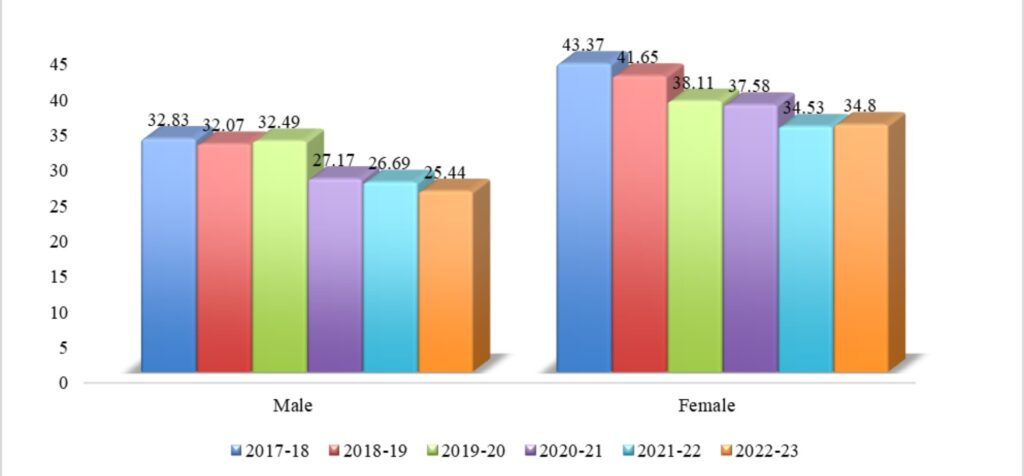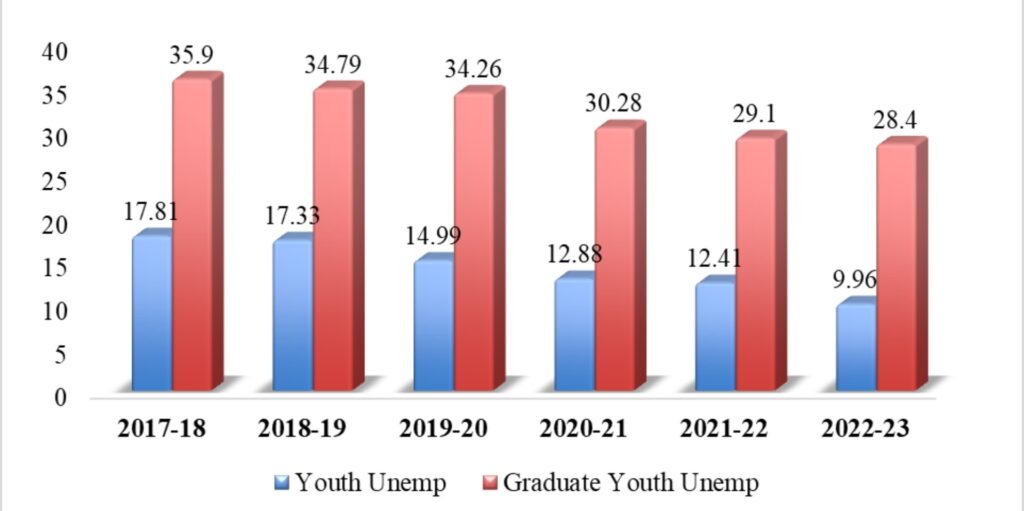Dr. Shiba Shankar Pattayat, Kumar Priyanshu & Simran Bhattarai

India is home to more than 600 million people aged between 18 and 35, with 65% under the age of 35, according to the UN estimates (August,2023). The unemployment rate among graduates aged 15 years and above has shown a positive trend, decreasing from 14.9% in the previous year to 13.4% during the period from July 2022 to June 2023, according to the latest findings from the Periodic Labour Force Survey (PLFS) conducted by the Ministry of Statistics & Programme Implementation.
In this remarkable achievement, Chandigarh emerged with the lowest unemployment rate at 5.6%, closely followed by Delhi at 5.7% for the same period (PTI, 2023).
However, a closer examination of the data reveals a different perspective. While the overall unemployment rate appears favorable for both males and females, a deeper exploration highlights certain concerns regarding the optimal utilization of human capital (see figure 1).
Figure 1: Unemployment rate by Gender (%)

Traditionally, graduates are deemed to be employed in high-skilled sectors, possessing the necessary skills, capabilities, and knowledge. Yet, a detailed analysis of the PLFS employment data indicates an increase in the participation rate in the agriculture sector, coupled with declines in major sectors like manufacturing, non-manufacturing, and the service sector. The most significant decline is observed in the service sector over the years. At the same time, there is a significant increase in the participation of graduates in the agricultural sector where they are self-employed.
Figure 2: unemployment status in India among youths (%)

This trend raises questions about the effective utilization of human capital. While experiencing a rise in participation, the agriculture sector is characterized by statistics. Out of the 20.57% of individuals employed in the agriculture sector, a staggering 93.81% are self-employed, with only 0.9% securing regular formal employment, leaving the majority in casual employment (see figure 2). This situation warrants attention and improvement. The difference in graduated youth participation in agriculture raises the question of effective government policy intervention.
Table 1: Graduate youth unemployment rate by industrial sector in India
| 2017-18 | 2018-19 | 2019-20 | 2020-21 | 2021-22 | 2022-23 | |
| Agriculture | 14.74 | 14.43 | 17.13 | 22.1 | 19.87 | 20.57 |
| Manufacturing | 12.52 | 10.4 | 12.01 | 11.14 | 12.12 | 11.68 |
| Non-manufacturing | 4.32 | 4.93 | 5.14 | 5.47 | 4.43 | 5.24 |
| Service | 68.42 | 70.24 | 65.72 | 61.29 | 63.58 | 62.51 |
Source: Author’s estimation using PLFS data
In contrast, the manufacturing and service sectors present a more favorable scenario, boasting the highest rates of regular employment for graduates and minimal casual employment. However, the non-manufacturing sector reveals a less optimistic picture, with 36.77% of individuals having casual employment, signaling a potential underutilization of human capital. Only 42.36% of people in this sector enjoy regular employment, highlighting the need for strategic interventions.
While the headline figures point to a positive trajectory in reducing graduate unemployment, the deeper analysis reveals a complex employment landscape, urging policymakers to address sectoral imbalances and ensure that the potential of the country’s human capital is maximized for sustained economic growth. The reports of PLFS data show the urgent requirement to up-skill the available labor force and utilize human capital for sustainable long-term growth.
Table 2: Graduate youth unemployment rate by types of employment, 2022-23
| 2022-23 | ||
| Self Employment | Regular | Casual |
| 93.81 | 0.9 | 5.29 |
| 33.80 | 64.19 | 2.01 |
| 20.87 | 42.36 | 36.77 |
| 25.57 | 73.26 | 1.18 |
Source: Author’s estimation using PLFS data
India’s aims to be in the top five economies of the world and progress is underway. The government of India has initiated many programs to up-skill the youth like Pradhan Mantri Kaushal Vikas Yojana, Ministry of Skill Development and Entrepreneurship (MSDE), National Education Policy (2020) and Skill India. The data from ILO and PLFS show under-utilization of human capital which will lead to devastating effects in the long-term growth of India.
According to the Economic Survey 2018-19, India’s demographic dividend is expected to persist around 2056, with 2041 being its peak (East Asia Forum,2019). According to United Nations Population Fund (UNFPA), demographic dividend means, “the economic growth potential that can result from shifts in a population’s age structure, mainly when the share of the working-age population (15 to 64) is larger than the non-working-age share of the population (14 and younger, and 65 and older)”.
The working age population is expected to reach 59% (S&P Global Reports,2019). To accelerate the growth, we not only need to address lesser participation in the service sector but also expedite female employment rate in all the sectors. There is a high need to unlock India’s demographic potential as the birth rates are declining every year. India’s median age is 28 which is comparatively lower than Japan and USA, which has 49 and 37 respectively. Thus, the increased labor force needs to be effectively utilized using effective government reforms, education and health; before the working population turns into a dependent population increasing the economic burden of the nation.
Dr. Shiba Shankar Pattayat is an Assistant Professor, at the Dept of Economics, Christ Deemed to be University, Bangalore Yeshwanthpur Campus, along with Kumar Priyanshu & Simran Bhattarai, students of the Dept. Views are Personal.






















